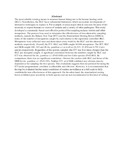| dc.description.abstract | The most reliable existing means to measure human biting rate is the human landing catch
(HLC). Nonetheless, the HLC faces substantial limitations which necessitate development of
alternative techniques to replace it. For example, it raises major ethical concerns because of the
necessity to expose humans to vectors of malaria and a variety of other pathogens. This study
developed a community-based cost-effective protocol for sampling malaria vectors and other
mosquitoes. The protocol was used to determine the effectiveness of two alternative sampling
methods, namely the Ifakara Tent Trap (ITT) and the Standardized Resting Boxes (SRB) in
terms of the number of mosquitoes caught by each relative to the rigorously controlled HLC.
Mosquitoes were collected once and three times every week by the HLC and the alternative
methods respectively. Overall, the ITT, HLC and SRB caught 44,848 mosquitoes. The ITT, HLC
and SRB caught 168, 143 and 46 An. gambiae s.l. as well as 26,315, 13,258 and 4,791 Culex
species respectively. Regardless of the species sampled, the ITT was five times cheaper than the
HLC per mosquito caught. A significant correlation between the numbers caught by HLC and
ITT was observed for An. gambiae s.l. (P<O.OOI) and for Culex species (P=O.003). By
comparison, there was no significant correlation ~8tween the catches with HLC and those of the
SRB for An. gambiae s.l. (P=O.195). Neither ITT .n<]r SRB exhibited any obvious density
dependence for sampling the two species. This evaluation suggests that our protocol for using the
ITT under programmatic condition is affordable and effective. However, it is recommended that
the trap be evaluated further under conditions of routine surveillance at a full scale to fully
'establish the true effectiveness of this approach. On the other hand, the standardized resting
boxes exhibited poor sensitivity to both species and are not recommended in this kind of setting. | en |


